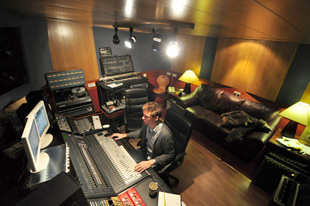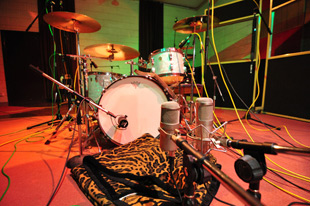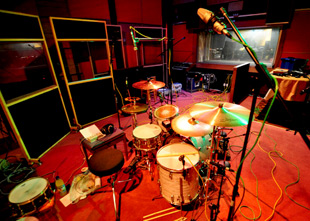![]() ‘I’d say I am a bit of a gear geek – I am obsessed with mics and preamps,’ confesses Audio Dynamite founder Marcus Attwood – the man behind the Vintage Rock Drum Loops range.
‘I’d say I am a bit of a gear geek – I am obsessed with mics and preamps,’ confesses Audio Dynamite founder Marcus Attwood – the man behind the Vintage Rock Drum Loops range.
‘Recording drums is my favourite part of a production – you get the chance to get all your favourite mics out and experiment with them – I think it’s a bit of a dark art really…
‘My earliest memory is following my dad’s band around and listening to them play local clubs,’ he says, by way of an introduction. ‘I started learning to play organ and guitar at an early age and have always been interested in the recording aspect.
 ‘I borrowed a four-track reel-to-reel recorder [a 1970s Teac] in my teens and experimented with it for hours. It sounded amazing. I went on to study music technology and electronic engineering at university and then set up a recording studio at a local rehearsal studio. After a few years spent producing demos and albums for local bands, I went into teaching music and music technology. Since then I’ve been involved with lots of aspects of music and production, live sound, stage management, performing.’
‘I borrowed a four-track reel-to-reel recorder [a 1970s Teac] in my teens and experimented with it for hours. It sounded amazing. I went on to study music technology and electronic engineering at university and then set up a recording studio at a local rehearsal studio. After a few years spent producing demos and albums for local bands, I went into teaching music and music technology. Since then I’ve been involved with lots of aspects of music and production, live sound, stage management, performing.’
Having founded Audio Dynamite, he assembled the production team that now produces the Vintage Rock Drum Loops range of drum loops and sample for music production. The inspiration seems to have come from those early years.
‘My younger brother followed my dad’s footsteps and learned to play the drums in his teens,’ Attwood explains. ‘He has played in many bands and toured with Towers of London when they were unexpectedly without a drummer a few years ago. We were both influenced by Zeppelin and Hendrix, among a lot of other artists, so when we discussed the idea of creating a high -quality drum loop package we naturally wanted to play to our strengths. John Bonham is probably the single biggest influence on my brothers playing so the Vintage Rock series felt very natural. ’
Essential to drum recording is the microphone set-up, which plays a large part in determining the character of the sound as much as the playing style.
Hit record...
‘I wanted to get the miking absolutely nailed down before we went into the studio, so we did many hours of pre-production in a converted barn,’ Attwood reveals. ‘Because of the nature of the project, I wanted to use similar techniques to the original producers we were paying homage to.
 ‘When you think 70s drums, you instantly think Glyn Johns. So we spent a long time choosing the right mics and finding the best angles and distances. This method uses only four mics – one in front of the kick, one snare mic and the two ambient mics – top and side. The Beyer ribbon mics sound fabulous – very punchy with lots of detail and a very smooth top end. The stereo image is really cool to listen to on headphones.
‘When you think 70s drums, you instantly think Glyn Johns. So we spent a long time choosing the right mics and finding the best angles and distances. This method uses only four mics – one in front of the kick, one snare mic and the two ambient mics – top and side. The Beyer ribbon mics sound fabulous – very punchy with lots of detail and a very smooth top end. The stereo image is really cool to listen to on headphones.
‘We wanted to offer a couple of mix options (an important selling point), so we also set up a more contemporary multi-mic system at the same time – with large diaphragm overheads, room mics and close mics on the toms. This means all the loops are not only multi-format but you can choose between two entirely different sounding mixes – or even remix it yourself with the multitrack pack.’
 After the mics, the preamplifiers and signal path take their turn. In this case the mixing desk was an analogue Audient ASP008.
After the mics, the preamplifiers and signal path take their turn. In this case the mixing desk was an analogue Audient ASP008.
‘I had quite a few different preamps at my disposal,’ Attwood begins. ‘We used a vintage Helios preamp from the Rolling Stones mobile truck to record the Glyn Johns four mic arrangement. That gave it the required vintage vibe. For the contemporary mics I wanted clean signal with lots of dynamic range and a low noise floor. The ASP008 was perfect for that job.
‘For recording drums, I want lots of dynamic range but with control of the peaks. It’s a very subtle compression at the top end of the range that helps define the drums for me. On top of that, the ASP008 has the variable impedance selector which is fabulous for adding an additional tonal palette. All my mics responded differently to the impedance changes, most were subtle except for the ribbons which is what the feature is really intended for. It was a fun experiment to find the appropriate impedance tone for each channel. The high-pass filter is so easy to use as well, and is really important to clean up any rumble when recording a drum kit. It’s only a minor thing but I love the soft-start +48V. Gone are the days of the phantom thump.’
And the sample library?
‘The Vintage Drums loop packs are a unique product,’ Attwood asserts. ‘We are delivering awesome sounding drum loops in a very flexible way. Each pack consists of a single tempo with main loop and variations, crash starts and fills. You can choose from a variety of formats to suit your level of production, from Apple Loops for Garage Band users, to full multitrack files for the Pro Tools or other DAW sessions. They are great for film and TV beds as well as traditional songwriters as they are arranged in clearly progressive sections that would relate to a verse, chorus...
‘The drum loops are also insanely cheap, so customers can afford to buy a pack at a time and build their collection over time. We have customers all over the world – some are bedroom enthusiasts, others are using them as temp tracks for major artist pre-production.’
More: www.audiodynamite.co.uk{jcomments on}